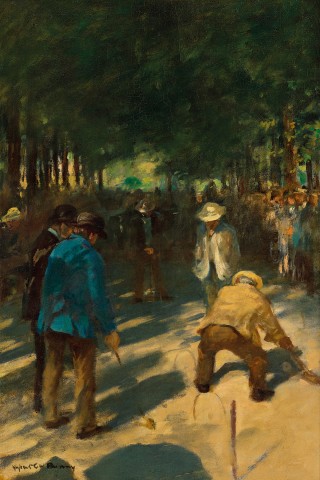JOUEURS DE CROQUET (LUXEMBOURG), c.1909
RUPERT BUNNY
oil on canvas
81.5 x 54.0 cm
signed lower left: Rupert CW Bunny
Private collection, France
Nevill Keating Pictures, London, 2000
Christie’s, London, 16 December 2008, lot 5
Private collection, United Kingdom
Société Internationale de Peinture et Sculpture, Galeries Georges Petit, Paris, 1910, cat. 22
Gérard-Austin, A., The Greatest Voyage: Australian Painters in the Paris Salons, 1885 – 1939, doctoral thesis, Université Paris 1 – Panthéon-Sorbonne, March 2014, vol. 2, pp. 18, 83, 128 (illus.)
Thomas, D., The Life and Art of Rupert Bunny, A Catalogue Raisonné in Two Volumes, Thames & Hudson, Melbourne, 2017, vol. 2: cat. O290, p. 43 (as ‘Jeux de Croquet, Jardins du Luxembourg’)
One of the most internationally successful Australian artists of his generation, Rupert Bunny was born in Melbourne and first trained at the National Gallery School, before settling permanently in Paris during the early 1890s where the belle époque was at its height. By 1904, he had become the first Australian artist to receive an honourable mention in the Société des Artistes Francais; was elected a Sociétaire of various French exhibiting institutions; and enjoyed the prestige of being the only Antipodean artist until then to have his work acquired by the French State, with Après le bain, c.1904 purchased from the New Salon for the Musée de Luxembourg (now the Musée d’Orsay).
While Bunny continued to evoke an opulent, often indolent elegance in his works produced around the fin-de-siècle, by the pre-war years his paintings were evolving towards a more modern focus upon Parisian outdoor leisure, ‘la chasse au bonheur’. Accordingly, around 1909 Bunny embarked upon a series of works in which his abiding preoccupation with colour and light was mediated by a new emphasis on anecdote in a signature Parisian location – the Luxembourg Gardens – where he frequently sketched with fellow expatriates Phillips Fox and his wife Ethel Carrick, and Kathleen O’Connor. Yet while portraying the same gentle life of the affluent bourgeoisie, Bunny’s tonally denser oils such as the exquisite Jouers de Croquet, Luxembourg, c.1909 diverge from the lighter, more freely executed interpretations of O’Connor and Carrick Fox in particular – both of whom believed that the modern path lay in embracing Impressionism and its drive towards the fragmentation of form.1 By contrast, Bunny’s paintings from this period such as the closely related In the Luxembourg Gardens, c.1909 (Art Gallery of New South Wales); Luxembourg Gardens, c.1908 – 10 (Wesfarmers Collection of Australian Art, Perth); and Bridge (Luxembourg), c.1909 (private collection, Melbourne) are distanced from immediate experience, declaring themselves products of the studio and intellect. Notwithstanding such commitment to studio practice however, his small pochades which formed the basis for many of the final compositions – alongside numerous pencil impressions produced by Bunny en plein air (and contained in his Villa Lilli sketchbook in the National Gallery of Victoria) – reveal that in the Luxembourg Gardens at least, the practices of the tonal academic and the Impressionist were merging.2
Capturing brilliantly the spirit and élan of Parisian society in these pre-war years, Jouers de Croquet, Luxembourg, c.1909 attests to the way in which Bunny successfully created an art appropriate to his time and the conditions of modernity – assimilating avant-garde modes into establishment practice. Transforming the prosaic into the poetic, thus Bunny offered contemporary audiences a vision of the everyday exuding joie de vivre and ‘…a peaceful remoteness from the ‘sturm and drang’ of modern life’.3 As leading French art critic of the day Gustave Geffroy observed of the artist’s celebrated solo exhibition at Galerie George Petit, Paris later that decade, Bunny’s paintings express ‘the luminous joy of daylight… and the pleasure of living in the shadow of trees looking out on a festival of sunshine… [He] is a realist and a visionary, an observer of truth and a poet of the world of dreams.’4
1. Edwards, D., ‘From fin de siècle to belle époque’ in Edwards, D et al., Rupert Bunny: Artist in Paris, Art Gallery of New South Wales, Sydney, 2009, p. 81
2. Ibid.
3. Sydney Morning Herald, 22 September 1911, p. 7
4. Geffroy, G., ‘Rupert Bunny: Introduction’, Exposition Rupert C.W. Bunny, Galeries Georges Petit, Paris, 1917, n. p.
VERONICA ANGELATOS
